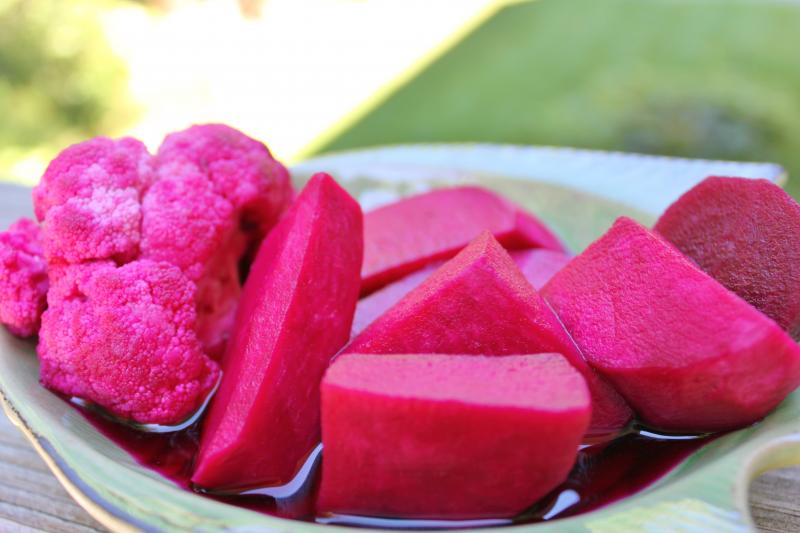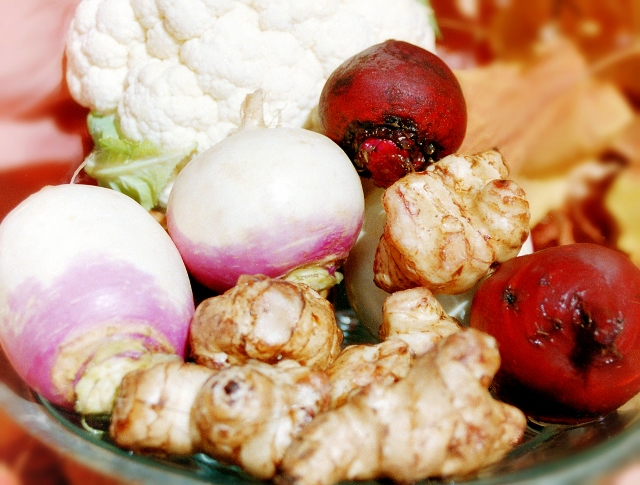Delights from the Garden of Eden
Pickles (Turshi)

No Iraqi meal is complete without the familiar bowl of turshi (pickles). Along with the pickled vegetables themselves, people also like to take a sip or two of the pickling juice. The commercially made pickled mango ('amba) would sometimes replace the homemade pickles, especially with the famous fish dish Masgouf (Read about it in Delights from the Garden of Eden, pp. 360-62).
Turshi is also consumed as snack food. It is quite common to see a cucumber-pickle vendor carrying a large basket on his head, wandering the busy streets of Baghdad.
Turshi shalgham (pickled turnip):
A popular winter treat. Turnips and beets are traditionallypreserved in simple brine and kept in large glazed earthenware jars called bastouga. They are left for forty days on the sunny side of the flat roof of the house, to let it mellow under the gentle warmth of the winter sun.
Opposite, is a fast method, which works anytime, anywhere. Turnips and beets are essential for making this kind of pickles. Beets will give the vegetables a beautiful pinkish hue. The addition of cauliflower and sunchokes (Jerusalem artichokes) is optional, but they do add a desirable variety, especially sunchokes. In Iraq, they are called almaaz, a possible variant on the Turkish ‘yerelmasi.’ 
'Amba (Mango Pickle)
A popular condiment in Iraq, imported from India.

A recipe for pickled turnip:
3 pounds medium or small turnips (If wished, also use: 1small head of cauliflower and 2 pounds sunchokes)
2 pounds beets
Uniodized salt for sprinkling
For the liquid:
2 tablespoons uniodized salt
6 cups white vinegar
5-6 juniper berries, optional
1. Wash vegetables very well. Cut off both ends of turnips and scrape away any brown spots. Peel them if skin is tough. Cut turnips crosswise into halves, then lengthwise into thick slices. (If used: divide cauliflower into florets, but leave sunchokes whole).
2. Put turnips (and cauliflower and sunchokes, if used) in a big colander fitted into a bowl. Sprinkle them generously with salt, fold them, and let them drain for about 10 hours. Toss them several times while draining.
3. Meanwhile, prepare the beets: peel them and cut them into thick slices. Put them in a medium pot, and cover them with plenty of cold water. Bring to a boil on high heat, then reduce heat and simmer the beets until half cooked. Let them cool off completely. Drain the beets, and set the liquid aside.
4. When vegetables are ready, put them in pickling jars, in alternate layers with the cooked beets.
5. Combine beet liquid and vinegar to make 12 cups of liquid. Stir in salt, and pour liquid into the jars. Press the vegetables a few times to allow color to distribute evenly among the vegetables and let air bubbles out. Make more of the liquid, if needed. The vegetables should be completely covered with it. Add the juniper berries if used.
Set aside for about a week in a cool shaded place, and use. They will stay good in a cool place for about a month even without refrigeration.
Copyright 2017 Delights from the Garden of Eden. All rights reserved.